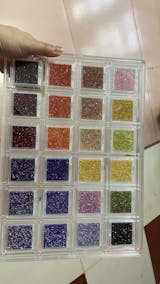Guest Post by Contributor Patrick Bailey
Introduction
There are so many reasons to consider cubic zirconia jewelry. For some, it’s to avoid the implications of mined diamonds. This begs the question, Is cubic zirconia jewelry good for the environment?
We’ll start by taking a look at the environmental concerns with diamonds, then explore whether cubic zirconia avoids these problems.
Where Are Diamonds Found?
Before understanding the environmental impact of diamonds, let’s review how diamond jewelry is made.
You probably know that diamonds are jewels that are found in nature. Diamonds exist hundreds of miles under the Earth’s crust.
How do you get down there? Diamonds are extracted using a few methods – all of which are terrible for the environment.
Alluvial Diamond Mining
One method is called alluvial diamond mining. In this process, workers divert entire rivers and build massive walls. When the river beds or ocean beds dry, miners start looking for diamonds.
Miners will sift through dirt and process it looking for diamonds. It’s easy to imagine the ecological harm of permanently diverting water sources. Such diversion ruins wildlife and ecosystems.
Open-Pit and Underground Mining
Other methods include open-pit and underground mining. These processes require digging holes massive and deep enough to find diamonds.
In open-pit mining, miners dig an enormous pit and process that dirt that comes out of it. They don’t fill the hole when they’re done, so there will forever be a pit in the landscape.
Underground mining uses explosions and two parallel tunnels. In one tunnel, miners constantly set off explosives to disturb the dirt. In the second tunnel, miners process the disturbed dirt and look for diamonds.
These styles of mining also disturb the environment. Explosions can scare off and kill wildlife. Digging destroys forestation and plants in an area. The heavy machinery required for mining uses huge amounts of fossil fuels.
Marine Diamond Mining
This process arguably produces the greatest impact on the environment. This mining process places a boat in a certain area of an ocean or lake. Attached to the boat is a massive drill on a rope. The drill drops to the ocean floor, drills through the dirt, and sucks up dirt to be processed for diamonds.
Mining for diamonds in this way destroys the ocean and disturbs the aquatic life in an area. The noise and activity disrupts fish, and the constant drilling reshapes the underwater ecosystem.
Environmental Concerns with Diamonds
Let’s consider the alternative to cubic zirconia jewelry: diamond jewelry. Never mind the ethical implications, how environmentally friendly is the process of mining diamonds?
The short answer is that mining for diamonds is terrible for the environment.
Digging the Diamonds
Did you know that 1,750 tons of earth needs to be extracted to find a 1.0 carat rough diamond? That’s a lot of environmental damage. The act of mining diamonds includes digging massive quantities of dirt and processing it to look for natural diamonds.
If water sources are nearby, they are dammed, moved, and rerouted. Damming impacts water quality for an area. Changes in water availability could even lead to worsening natural disasters in the future.
Machinery Required
How about the fossil fuels required to run these machines? Heavy machinery is required to dig and process the diamonds and such equipment often operates non-stop.
There are also modes of transportation used to scout different areas where diamonds may be located. This transportation could include boats, planes, or cars, all of which use additional fossil fuel.
Mining machinery creates a large carbon footprint. The burning of fossil fuel produces greenhouse gasses that weaken our ozone layer and accelerate global warming.
Roads to the Mines
It’s a sometimes-forgotten aspect of mining, but finding a new zone to dig for diamonds means more people going to a certain area. This could result in the creation of more roads and highways leading to the area.
Mining companies will remove or alter wildlife, trees, landscapes, and earth to create these roads. They might also alter the environment by erecting buildings and other structures that support their mining operations.
Overall Environmental Impacts
Big environmental impacts of mining include soil erosion, deforestation, and ecosystem destruction. Animals lose their homes, food chains are disturbed, and landscapes are forever changed.
Human residents of the area may be negatively affected by this. They might be stressed out because mining has created pollution and traffic. They might turn to drinking or using drugs to cope, maybe even needing drug or alcohol rehab because they’re having difficulty dealing with the massive changes around them.
Cubic Zirconia
How is cubic zirconia more environmentally friendly? For one, it’s not a mined substance. It’s a lab-created one.
This essentially means that many ecological concerns associated with diamonds disappear when you use cubic zirconia instead.
Environmental Benefits of Using Cubic Zirconia
Making jewelry with cubic zirconia is better for the Earth than diamonds.
CZ uses less large machinery, requires no digging, and doesn’t excavate thousands of tons of dirt. Making them requires fewer chemicals and fossil fuels, and there’s no need to alter water sources or entire ecosystems.
Cubic zirconia is good for the environment because it avoids mining and its consequences.
Conclusion
It’s a tall order to expect people to stop wearing jewelry. At this point, many people know the ethical violations associated with diamonds and mining them. Fewer people understand how diamond mining can hurt the environment.
Diamond mining is terrible for the ecosystems around the world, and cubic zirconia is a much better alternative. CZ has a smaller carbon footprint and doesn’t not contribute to deforestation or negative ecosystem impacts. When you’re looking for attractive jewelry, cubic zirconia is an environmentally friendly option.
Sources
withclarity.com - How Are Diamonds Mined?
http://thegreenerdiamond.org - Environmental Impact
u.osu.edu - Impacts









